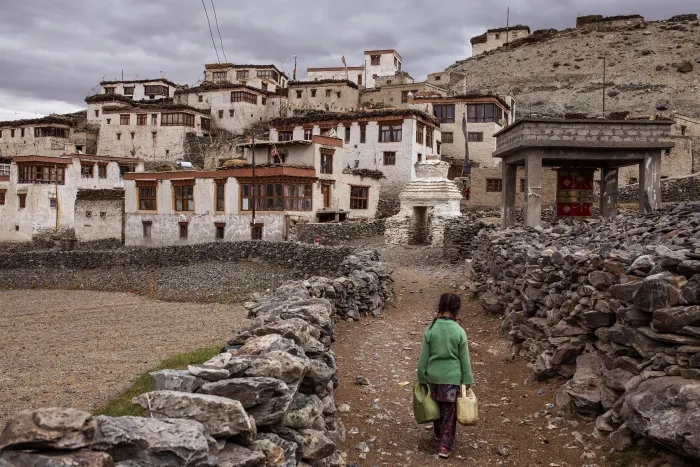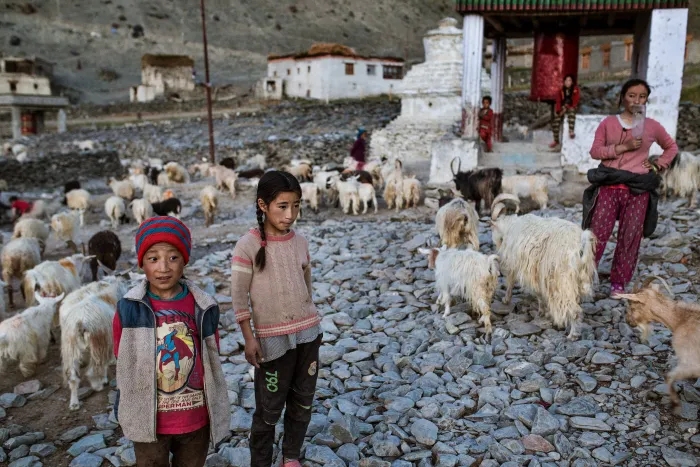
Ashley Crowther documented the effects of climate change and the black carbon in Indian Himalayas for four years. This epic adventure began in Kumik, an Indian village located in Zanskar Valley. Residents of Kumik have relied on water flowing from nearby mountain glaciers for many years. The glacier that once flooded Kumik has receded, and its snowfall is no longer as abundant.
The impact of black carbon on the drought is difficult to quantify. However, climate change and black carbon have combined to cause a severe drought.
Tashi Stobdan and Zangmo, his wife, welcomed the photographer to Kumik. He spent his summer drinking barley wine, chatting with local families and learning about their lives.
Crowther and Ravi Mishra followed the black carbon story across the mountains over the next few years. He then went to Jharia – a rural village reshaped from coal mines, and by burning fires. The entire area is on fire. They traveled on a train, stopping to share stories of local communities that they saw along the way.
The book Black Carbon & Himalayas combines Crowther’s photos and his in-depth reporting.
When we burn biomass, fossil fuels and biofuels the black carbon (also called soot) is released in the air. It then makes its way into the lungs where it can cause illness and even death. Black carbon is a by-product of stoves that are used to heat and cook in homes. It has a disproportionate impact on women, children and the elderly.
Black carbon, along with CO2, is a major contributor to climate changes, which adds to the complex web of health and environmental concerns in the Indian Himalayas. Crowther says that while climate change is having a warming effect on the Himalayas in general, black carbon has become more widely known for its ability to exacerbate climate change’s effects.
Crowther braved temperatures as low as -30 degrees Celsius to return to Kumik, in 2019. He traveled this time with his friend and colleague Tanzin Rigzin. “I will never forget my last visit in the dead winter, when I walked along the frozen Zanskar River for seven days with Tanzin. We froze our asses and slept in caves on the river’s bank.
The sun was nearly behind a mountain in the valley and the last flickers from winter light were reflecting off the snow-covered hillside. We saw the village with its houses.
Zangmo Stobdan recognized Crowther instantly and served them tea when they had finished their long trip to Kumik. Crowther recalls that the best part of this day was Zangmo Stobdan’s surprise when she saw us after a long time in her kitchen. It was a genuine act of hospitality and care. This memory will stand out amongst a variety of other extraordinary moments.
Even during happy moments, the environmental and health hazards of black carbon were always in mind. Crowther heard of a woman’s death due to respiratory problems, likely a lung disease exacerbated by smoking. If the smoke problem isn’t addressed, the suffering of people in Kumik could spread downstream.
Crowther discovered that black carbon can be solved during his journey. Liquified Petroleum Gas, or LPG, could be a solution. However, LPG remains expensive and out of reach for most communities and families. Governments could provide free LPG connections to pave the path for a more secure future.
Local citizens are also developing their own solutions. Tanzin Rigzin, who helped invent the “rocket” stove, introduced it to the photographer along the way. This affordable stove produces a flame that is smokeless. Crowther said that rocket stoves are a hit in Zanskar and many people use them. “I installed a few of them myself in the homes of my friends Tashi and Urgain in 2021. More are being installed elsewhere in the Himalayas.”
The photographer believes that inventions such as this one will work hand-in-hand in the future with larger-scale efforts to combat black carbon. He says that lifting people out poverty is the first step to enabling them to afford cleaner fuels on a long-term basis. He says that access to cleaner fuels is a priority, particularly in rural areas and the poorer parts of the country. Indoor air pollution and outdoor pollutants continue to affect millions of people every year.
The photographer continues to be in contact with Tashi and Urgain, who were both instrumental in the creation this work. Crowther: “They told me that this year there was not much snow, so less water would be available in the summer growing season.” “Water issues are a common problem, and people have to be prepared. But it doesn’t make it easier.”
Kumik residents have read the book. Crowther had tried to deliver copies to the village himself, but the mountain passes were too high at the time. He left them with Tanzin, who delivered them. He hopes to visit his friends very soon.
He reflects: “The last time that I was in Kumik, during the winter of 2020 the villagers said they hoped that their plight would raise awareness about water issues throughout the Himalayas.” “I hope my contribution has opened some eyes and ears about the real concerns of people who have had the least impact on climate change and glacier retreat.”
